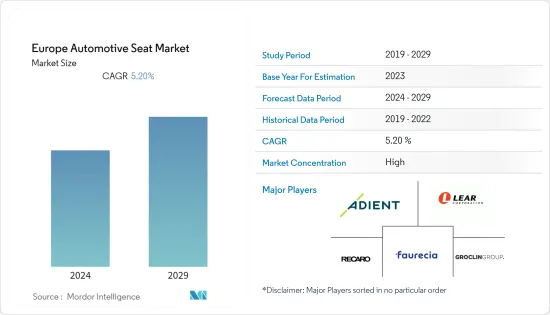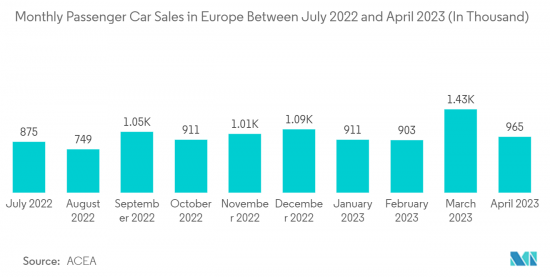PUBLISHER: Mordor Intelligence | PRODUCT CODE: 1406153

PUBLISHER: Mordor Intelligence | PRODUCT CODE: 1406153
Europe Automotive Seat - Market Share Analysis, Industry Trends & Statistics, Growth Forecasts 2024 - 2029

The Europe automotive seat market was valued at USD 12.21 billion, and it is expected to reach USD 21.96 billion in the next five years, registering a CAGR of around 5.2% during the forecast period.
Key Highlights
- Over the long term, the rising vehicle sales are expected to boost automotive seat production to meet the increasing demand. Increasing passenger comfort has become one of the most important considerations in the passenger car market, and seats are significant in this aspect.
- Consumer demand for safety and comfort in automobiles is a vital factor driving the changes in the manufacturing of automotive seats. Luxurious, comfortable, and safe automotive seating systems are gaining preference among consumers, which, in turn, is prompting OEMs to seek automotive seats that could satisfy consumer expectations. Further, growing concerns about the use of plastic and plastic disposal are causing automotive seat manufacturers to invest heavily in the research and development of new materials for manufacturing automotive seats.
- The powered seat and ventilated seat segments are expected to record a high growth rate because of the rising sales of luxury vehicles and the increasing adoption of such seats in mid-segment cars. Ventilated seats help in temperature regulation, which helps in reducing energy emissions through air conditioners, sunroofs, etc. Increased awareness about the intelligent seating solutions offered by manufacturers has enhanced the perceived quality. For instance,
- In January 2023, Fauresia SE introduced automotive seat design and manufacturing, which will help to reduce the number of components used in a standard seat from around 120 to 10 modules. The modules are easily assembled and disassembled, allowing the seat's components (such as the cover and cushions) to be replaced and new functions (such as massages, lumbar support, and so on) to be added over time.
- Over the years, the demand for lightweight seats has been rising. With concerns about fuel efficiency, the seats are focused on cutting down weight to aid the performance of vehicles. Additionally, sustainability is gradually becoming a key factor influencing consumer decisions. This pervasive trend is estimated to boost the demand for lightweight automotive seats to produce fuel-efficient and high-performance vehicles.
Europe Automotive Seat Market Trends
Increasing Demand for Aftermarket Upholstery Modifications May Drive the Market
- Aftermarket seats offer improved comfort and ergonomics, which are crucial factors driving the demand. Many customers seek seats that provide better lumbar support, cushioning, and adjustability to enhance their driving experience and reduce fatigue during long journeys.
- Further, performance-oriented seats designed for racing or sporty driving are gaining popularity among car enthusiasts. These seats often feature bolstering for better lateral support, lightweight construction, and racing-inspired designs.
- Sports seats, bucket seats, and racing-style seats are currently in high demand as these seats provide enhanced support and a sporty aesthetic. Additionally, ergonomic seats designed for long-distance driving, such as those with adjustable lumbar support and integrated ventilation, are also popular.
- As for materials, leather and faux leather are expected to remain in demand for their premium feel and durability. However, sustainable and eco-friendly materials like recycled fabrics and vegan leather alternatives are gaining traction due to increasing environmental consciousness.
- In the wake of soaring demand for comfortable and aesthetically appealing seats, companies are launching such products in order to bridge the gap and capitalize on this evolving opportunity in the aftermarket modification market. The demand for aftermarket seats will continue to grow due to increasing customization preferences, improved comfort and ergonomics, advanced features, and the desire for enhanced driving experiences.
- Further, heated seats are gaining prominence in Europe due to climatic conditions as they offer better comfort and convenience than conventional seats. On the other hand, powered seats are also seeing an apparent demand, especially in premium luxury vehicles. This trend will likely continue during the forecast period because of rising consumer purchasing power in emerging economies and increasing demand for SUVs and luxury vehicles.

Germany Captures the Major Market Share
- Germany leads the European automotive seat market, followed by Spain and France. Europe has the potential capability to manufacture advanced seats, which led the region to capture a significant share of automotive seat exports in the global market. Regarding seat manufacturing capabilities by country, Germany dominates the major share in the production of seats in Europe, followed by the United Kingdom and the Czech Republic.
- The factor likely to fuel the demand in the European automotive seat industry is the growing production of electric vehicles. Ventilated seats, which are used in electric vehicles, may witness a demand surge in the future as more customers start purchasing electric vehicles. Among the European countries, the Netherlands and Norway have been the leading markets in the electric vehicle industry, and the demand for ventilated seats is likely to witness significant growth over the forecast period in the region.
- With major carmakers in the region, automotive seats also have significant production facilities across the country. Germany has the largest and most dynamic economy in Europe. Germany's automotive seat market reflected a steady growth trajectory in 2021 despite weak market sentiment in overall car sales. The overall car sales of the country decreased by around 10.1% in 2021 compared to 2020.
- In 2022, Germany remained the leading passenger automobile market, with over 2.65 million units sold. Being home to the largest automotive seat manufacturers, Germany leads the way both in terms of production and revenue.
- For instance, in June 2022, Grammer AG (Grammer) announced the establishment of the Ergolab at its headquarters in Ursensollen, Germany, to produce ergonomic and comfortable seats. Team members at the Ergolab work on research and pre-development projects, as well as rigorous comfort and ergonomic testing on prototype and series production seats and components.
Europe Automotive Seat Industry Overview
The European automotive seat market is consolidated and majorly dominated by a few players, such as Adient PLC, Faurecia, and others. The market is highly driven by factors like advanced technology, more comfort, growing investment in R&D projects, and a growing market of electric and autonomous vehicles around the region. To provide a more luxurious experience to the people, major automotive seat manufacturers are investing in R&D. For instance,
In July 2023, at the IAA Mobility 2023 event in Munich, Germany, Faurecia announced its technology in three strategic growth areas: electrification and energy management, safe and automated driving, and digital and sustainable cockpit experiences. Forvia will demonstrate seats, electronics, interiors, lighting, HMI, and displays that help to reduce CO2 emissions in the cockpit.
Additional Benefits:
- The market estimate (ME) sheet in Excel format
- 3 months of analyst support
TABLE OF CONTENTS
1 INTRODUCTION
- 1.1 Study Assumptions
- 1.2 Scope of the Study
2 RESEARCH METHODOLOGY
3 EXECUTIVE SUMMARY
4 MARKET DYNAMICS
- 4.1 Market Drivers
- 4.1.1 Increasing Demand for Aftermarket Upholstery Modifications May Drive the Market
- 4.2 Market Restraints
- 4.2.1 Fluctuation in Raw Material Prices
- 4.3 Industry Attractiveness - Porter's Five Forces Analysis
- 4.3.1 Threat of New Entrants
- 4.3.2 Bargaining Power of Buyers/Consumers
- 4.3.3 Bargaining Power of Suppliers
- 4.3.4 Threat of Substitute Products
- 4.3.5 Intensity of Competitive Rivalry
5 MARKET SEGMENTATION (Value in USD)
- 5.1 By Material
- 5.1.1 Leather
- 5.1.2 Fabric
- 5.1.3 Other Materials
- 5.2 By Technology
- 5.2.1 Standard Seats
- 5.2.2 Powered Seats
- 5.2.3 Ventilated Seats
- 5.2.4 Child Safety Seats
- 5.2.5 Other Seats
- 5.3 By Vehicle Type
- 5.3.1 Passenger Car
- 5.3.2 Commercial Vehicle
- 5.4 Geography
- 5.4.1 Germany
- 5.4.2 United Kingdom
- 5.4.3 Italy
- 5.4.4 France
- 5.4.5 Netherlands
- 5.4.6 Spain
- 5.4.7 Rest of Europe
6 COMPETITIVE LANDSCAPE
- 6.1 Vendor Market Share
- 6.2 Company Profiles
- 6.2.1 Adient PLC
- 6.2.2 Faurecia
- 6.2.3 Groclin SA
- 6.2.4 Recaro Group
- 6.2.5 Lear Corporation
- 6.2.6 Sparco SpA
- 6.2.7 Brose Fahrzeugteile GmbH & Co. KG
- 6.2.8 Britax
- 6.2.9 Maxi-Cosi
- 6.2.10 RENATO Auto Spezialsitze GmbH
7 MARKET OPPORTUNITIES AND FUTURE TRENDS




